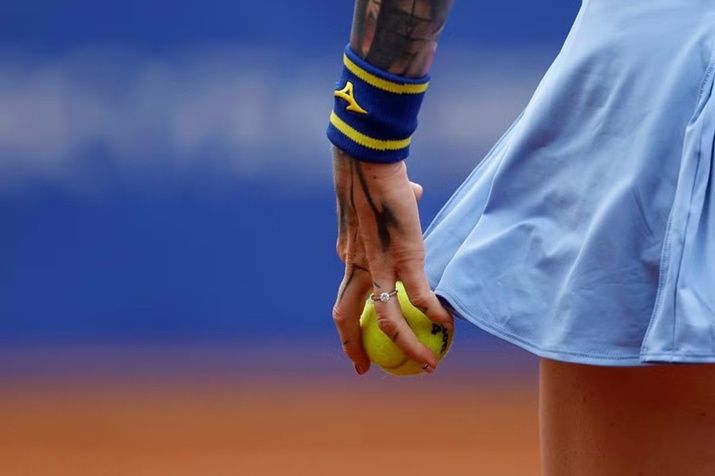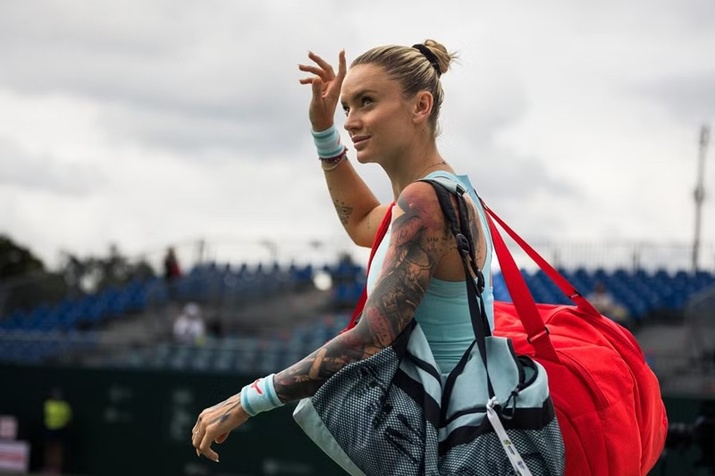EXCLUSIVE: Czech tennis sensation Tereza Martincova discusses her comeback after a lengthy hiatus
Special thanks to Flashscore for this in-depth interview. For more insights, visit https://www. flashscore.com/
After an eight-month break, Czech tennis player Tereza Martincova has re-entered the competitive arena. In this exclusive chat with Flashscore, she shares her journey, the transformative changes in her game, and her ambitions on the WTA Tour.

Photo credit: Jacob King / PA Images / Profimedia
Known as a bit of a “rebel” in the tennis world, Martincova’s striking tattoos and candid nature have set her apart. Back in early 2022, this 30-year-old from Prague reached a career-high ranking of 40 in the WTA. She has triumphantly faced off against top-tier players, including Samantha Stosur and Jelena Ostapenko.
Having resumed play in mid-March after her extended break, Martincova is still working to regain her confidence and find her groove. Despite a challenging 4–6 record this season, her determination remains unwavering.
In an enlightening discussion with former pro Kateřina Teruzzi, she elaborates on the life of a tennis player navigating uncertain times.
On her return to the court
“The initial phase was pretty frantic. I dove straight into matches as soon as I began training, despite my doctors and physio warning me it might be unwise. Their expertise proved right.”
“In my first two tournaments, I quickly realized my leg wasn’t fully prepared. I faced new challenges, including bone edema due to bones knocking against each other.”
“I had to pause my training for an additional three to four weeks. They even cautioned me it could take up to three months for a full recovery. It was a learning experience; during practice, I could control my movements, but matches demanded a different mindset.”
On team dynamics
“My physiotherapist has become a crucial part of my journey. I’ve come to rely on their expertise more than ever, especially during my preparation.”
Adjustments in daily routines
“My routine has drastically changed. I used to train intensively, but now I have to balance my on-court time with specialized exercises due to my leg issues.”
“It’s a new approach for me, and stepping up my game in this way has been essential.”
Tweaking her technique
“I once struggled with wrist problems, leading to string changes that fortunately averted surgery. With my leg, however, it’s a different story. I must be careful not to adjust my technique too much. Leaning into my leg is vital, yet I find myself holding back.”
“My style requires me to engage my body, as I don’t have the arm strength to rely solely on that.”

Photo credit: ČTK / Lebeda Pavel
On embracing the challenge of tournaments
“Coming back feels like a continuous process. This is the longest break I’ve ever had. After surgery, which was expected to be minor, I now face new uncertainties. I’m learning how to navigate this unfamiliar territory.”
“Accepting this new reality is crucial as I enter tournaments with fresh perspectives. It’s all about understanding what my injury allows and where I can push my limits.”
“I’m learning that playing more matches often exacerbates my condition, and I’ve had to rely on painkillers, which complicates my ability to evaluate my performance against my previous standards.”
The psychological aspects of a long break
“Stepping back from tennis has been beneficial. It was a necessary break from the grind of competition. I didn’t experience a depression of any sort; trust in my ability remained strong because of my amazing support team.”
“I took everything one step at a time, and engaging with my team positioned me to come back stronger.”
No psychologist needed
“I choose not to work with a psychologist since I have a solid support network around me, including my fitness coach, Michal Mirejovsky, who provided invaluable support during my recovery.”
“My family has also been a pillar of strength, making professional help unnecessary.”
Navigating uncertainty
“I’m in a constant state of flux right now. I can’t predict whether I’ll enter a tournament next week, nor can I foresee how I’ll feel in the days to come.”
“After Trnava, I questioned whether the pain would worsen or improve daily. Experience helps as I create a flexible approach to my schedule.”
Observations on changes in the WTA circuit
“I’ve been away long enough to notice some shifts, particularly regarding the balls. As I age, these things become more apparent.”
“There’s ongoing effort to enhance player conditions, aiming to offer the best experiences possible, which tends to favor top players.”
“Financial equity remains a challenge. While we do earn, there’s a persistent issue with how revenues are redistributed, leaving many players undervalued compared to their counterparts in the NHL, NBA, and NFL. The situation is evolving as players advocate for change.”

Photo credit: Francois Asal / Panoramic / Profimedia
Involvement in the PTPA
“I was part of the initial discussions around the PTPA (Professional Tennis Players Association). Novak Djokovic has spearheaded significant efforts for player advocacy and education on our current conditions.”
“We received valuable insights during the formation process, which reinforced my belief in the importance of these efforts.”
Future aspirations beyond playing
“I have a strong desire to coach. This past season has solidified that ambition. Having a clear vision for my future eases the pressure of my impending retirement from competitive play.”
Martincova’s driving force
“My passion for tennis is unwavering, and I aim to prove to myself that I can still rise to the occasion. The challenge fuels my motivation. I don’t feel like I’ve reached my peak yet; as long as my knee holds up, I’ll keep pushing forward.”
Future objectives
“My plans evolve with each tournament, heavily influenced by my physical condition. It’s essential for me to gauge my knee’s resilience and capacity for consecutive tournaments.”
“This surgery has taught me the importance of taking things one step at a time. I aspire to compete at the highest levels once again.”




